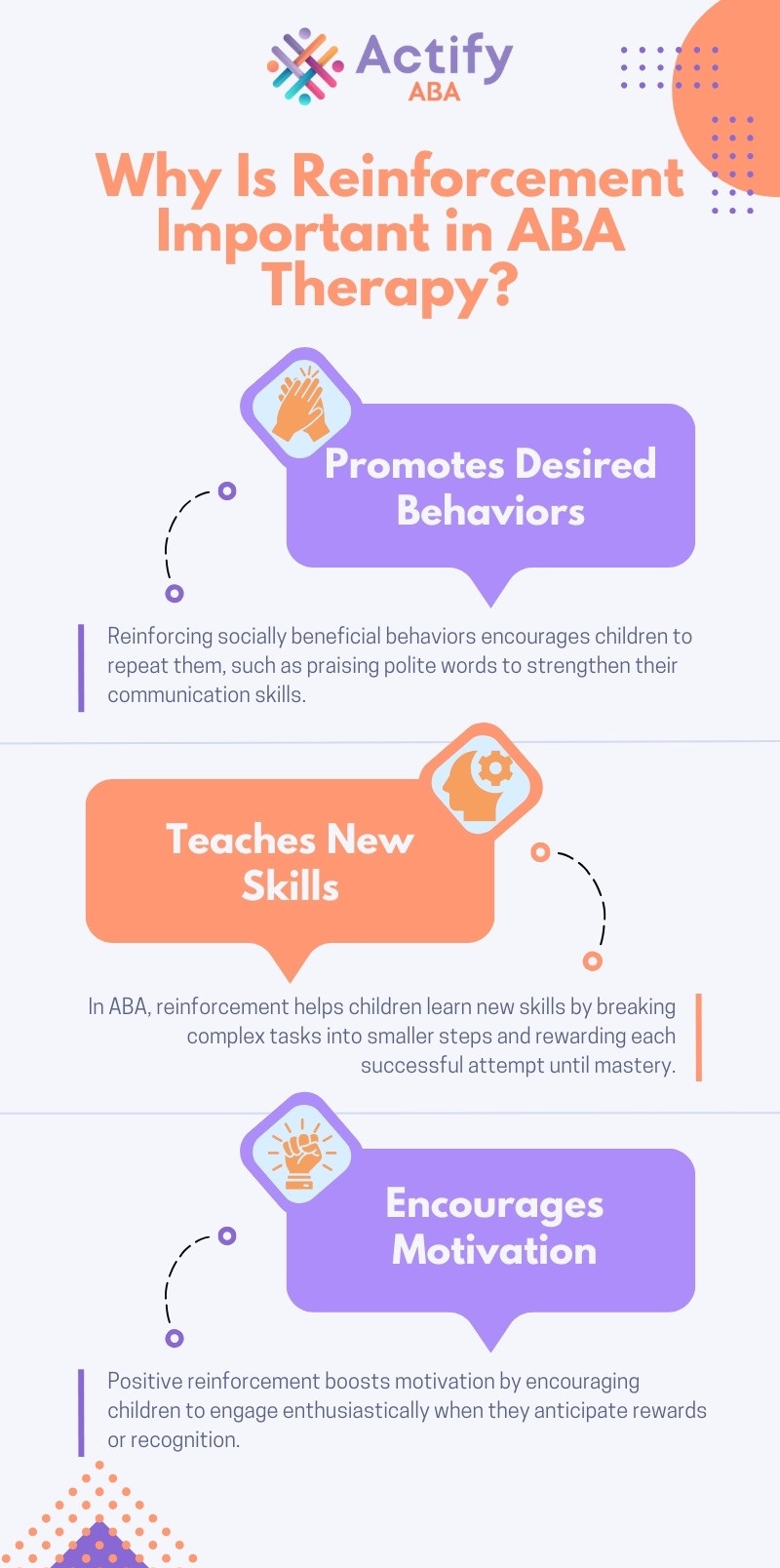
Key Points:
- Reinforcement in ABA is a method used to increase the likelihood of a desired behavior occurring again.
- There are two types of reinforcement: positive and negative, each having a specific effect on behavior.
- Understanding reinforcement is crucial for parents and therapists to help children make progress in skill development and behavior management.
Reinforcement in Applied Behavior Analysis (ABA) therapy is a technique that involves encouraging the repetition of desirable behaviors. It helps to shape the way children respond to their environment and learn new skills. By understanding how reinforcement works, parents and practitioners can better support children in reaching their goals. Let’s explore reinforcement in detail to understand its importance and how it plays a significant role in ABA therapy.
What Is Reinforcement in ABA?
Reinforcement in ABA refers to a strategy used to increase the likelihood that a specific behavior will happen again in the future. The goal is to encourage the repetition of a positive behavior by following it with a reward, or reinforcement. Essentially, when the behavior is followed by something reinforcing, the behavior is more likely to be repeated. There are two primary types of reinforcement:
- Positive Reinforcement: Adding a pleasant stimulus after the desired behavior occurs (e.g., giving praise, offering a small treat).
- Negative Reinforcement: Removing an unpleasant stimulus when the desired behavior occurs (e.g., taking away a chore when a task is completed).
Reinforcement is a cornerstone of ABA therapy because it not only encourages the development of new behaviors but also ensures those behaviors are maintained over time. By reinforcing desired actions consistently, an ABA therapist helps children learn and grow, making progress more sustainable.

How Does Reinforcement Work in ABA?
Reinforcement in ABA therapy relies on timing and consistency to be effective. To strengthen the desired behavior, the reinforcement should follow right after the behavior occurs. The closer in time the reward is to the action, the more likely the child will associate the behavior with the reinforcement.
Equally important is being consistent. If a child receives reinforcement only occasionally for a certain behavior, they may struggle to make the connection between their actions and the reward. By consistently reinforcing the behavior, it becomes ingrained. For instance, if a child consistently receives praise for using polite words like “please” and “thank you,” they are more likely to continue using them.
Another key factor is the reinforcement schedule, which determines how often reinforcement is given. At first, continuous reinforcement (rewarding every instance of the behavior) is used to help establish the behavior. As the behavior becomes more frequent, switching to intermittent reinforcement (rewarding only some occurrences of the behavior) can help maintain it in the long term.
4 Common Mistakes to Avoid When Using Reinforcement
While reinforcement is a powerful tool in ABA therapy, using it incorrectly can lead to unintended results. Understanding how to apply reinforcement properly is key to its effectiveness. Here are some common mistakes to avoid to ensure positive outcomes in therapy:
- Reinforcing Undesirable Behaviors: Reinforcement should only be used for positive behaviors. If reinforcement is applied to undesirable behaviors (e.g., a child is rewarded for throwing a tantrum), the behavior may increase, making it harder to address.
- Inconsistent Reinforcement: If reinforcement is applied inconsistently, the child may become confused or frustrated. Consistency is key to making reinforcement effective.
- Overusing Tangible Reinforcers: While toys and treats are great motivators, it’s important to gradually phase out tangible reinforcers and replace them with social or activity-based reinforcement as the child matures.
- Not Adjusting Reinforcement to Individual Preferences: Each child is different, and what works as a reinforcement for one child may not work for another. It’s important to tailor reinforcement to the child’s preferences and needs.

How Parents Can Use Reinforcement at Home
As a parent, you can easily incorporate reinforcement techniques at home to help support your child’s growth and progress. By using these strategies consistently, you can create an environment where positive behaviors are encouraged, making learning fun and effective. Here are some simple strategies to try:
- Provide Positive Feedback: Acknowledge your child’s efforts and accomplishments, no matter how minor. Whether they finish their homework or behave well during dinner, celebrating their progress encourages them to keep up the good work.
- Implement a Reward System: Set up a system where your child can earn tokens or stickers for completing tasks. These can then be exchanged for enjoyable activities or treats as a way to reinforce positive behavior.
- Offer Reward Choices: Allow your child to select their preferred rewards. If they have a range of activities they enjoy, let them decide which one they’d like to enjoy as a reward after completing a task.
- Stay Consistent: Consistency is crucial for effective reinforcement. Reward positive behaviors every time they occur to help your child connect the desired actions with the reinforcement, ensuring they understand what you’re encouraging.
Discover the Power of ABA Therapy with Actify
Grasping what reinforcement in ABA is and how it contributes to behavior change is essential for fostering positive results. Reinforcement is an effective tool that influences behavior, enhances learning, and supports children in reaching their fullest potential.
If you’re considering ABA therapy for your child, Actify is ready to assist. Our skilled therapists design personalized treatment plans that integrate reinforcement strategies to encourage your child’s progress. We proudly serve families in Maryland and nearby areas. Reach out today to learn how we can support your child’s development through ABA therapy!
